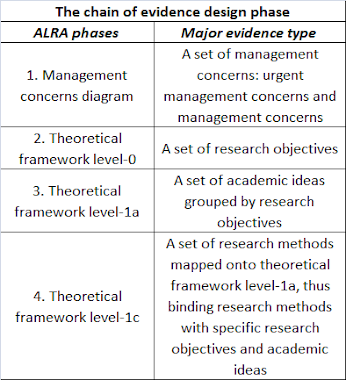Chain of evidence design and execution in the agile literature review approach (ALRA): an explanation:
Underlying the agile literature review approach is the chain of evidence. The chain of evidence establishes the validity and relevance of the actionable knowledge produced to address the management concerns as depicted in the management-concerns diagram of a case study (most likely a single case study). There are two chain of evidence exercises: (1) the design of the chain of evidence and (2) the execution of the chain of evidence. Further explanation is as follows:
I. On the chain of evidence design phase
The following pointer symbols should also be noted for further discussion:
Management concerns (MCs): can be urgent management concerns (UMCs) and management concerns (MCs)
Research objectives (ROs)
Academic ideas (AIs)
Research methods (RMs): including data capturing methods (DCMs) ad data analysis methods (DAMs)
The direction of pointers in the design phase is:
MCs ---> ROs ---> AIs --> RMs
[note: when writing dissertation report, try to provide pointer labels next to the pointers, e.g., RM1 [interview research on managerial competence] {pointer [pointer label]} for readers would have difficulties to comprehend sentences with lots of pointers without pointer labels .]
II. On the chain of evidence execution phase
|
The
chain of evidence execution phase
|
|
Dissertation report chapters
|
Major
evidence type
|
|
1.
Dissertation Chapter 4: Presentation of Research Findings
|
A set of
research findings (RFs) by research methods (RMs), associated with specific
research objectives (ROs)
|
|
2.
Dissertation report Chapter 5: Discussion of findings.
|
A set of
discussion findings (DFs), using specific academic ideas (AIs) and data analysis
methods on research findings (RFs).
|
|
3.
Chapter 6: Conclusions and recommendations
|
A set of
recommendations (Recommendation #), supported by specific discussion findings
(DFs), academic ideas (AIs), plus additional researcher's intellectual
judgements and imaginations, in response to specific ROs and management
concerns (MCs).
|
Note the additional pointer symbols used in the execution phase:
Research findings (RFs): from chapter 4: presentation of researching findings
Discussion findings (DFs): from chapter 5: discussion of findings
Recommendations (Recommendation #), e.g. recommendation 1, recommendation 2, etc.... in chapter 6: conclusions and recommendations.
The direction of pointers in the execution phase is:
RFs (by RMs, notably DCMs, directed at ROs) ---> DFs (drawing on RFs, AIs and DAMS, directed at ROs) ---> Recommendation # (drawing on DFs; directed at ROs and MCs)
Concluding remarks
Overall, the directions of the chain of evidence design phase and the chain of evidence execution phase work in opposite direction. Also, the design phase covers only dissertation report chapters 1 to 3 while the execution phase deals with dissertation report chapters 4 to 6. It is important to insert the pointers in the dissertation report with clear labels (not just the pointer symbols) so as to (a) make the dissertation report easier to follow and (b) the chain of evidence explicit and clear.
It should be pointed out that the quality of analysis, including the quality of chain of evidence, depend ultimately on the intellectual, research and writing skills of the researcher. The researcher's skills determine the chain of evidence design and execution quality of the dissertation report. This practice note solely deals with the clarity of chain of evidence in the agile literature review approach. The quality of line of reasoning also benefits substantially from the subject of argumentation.

No comments:
Post a Comment